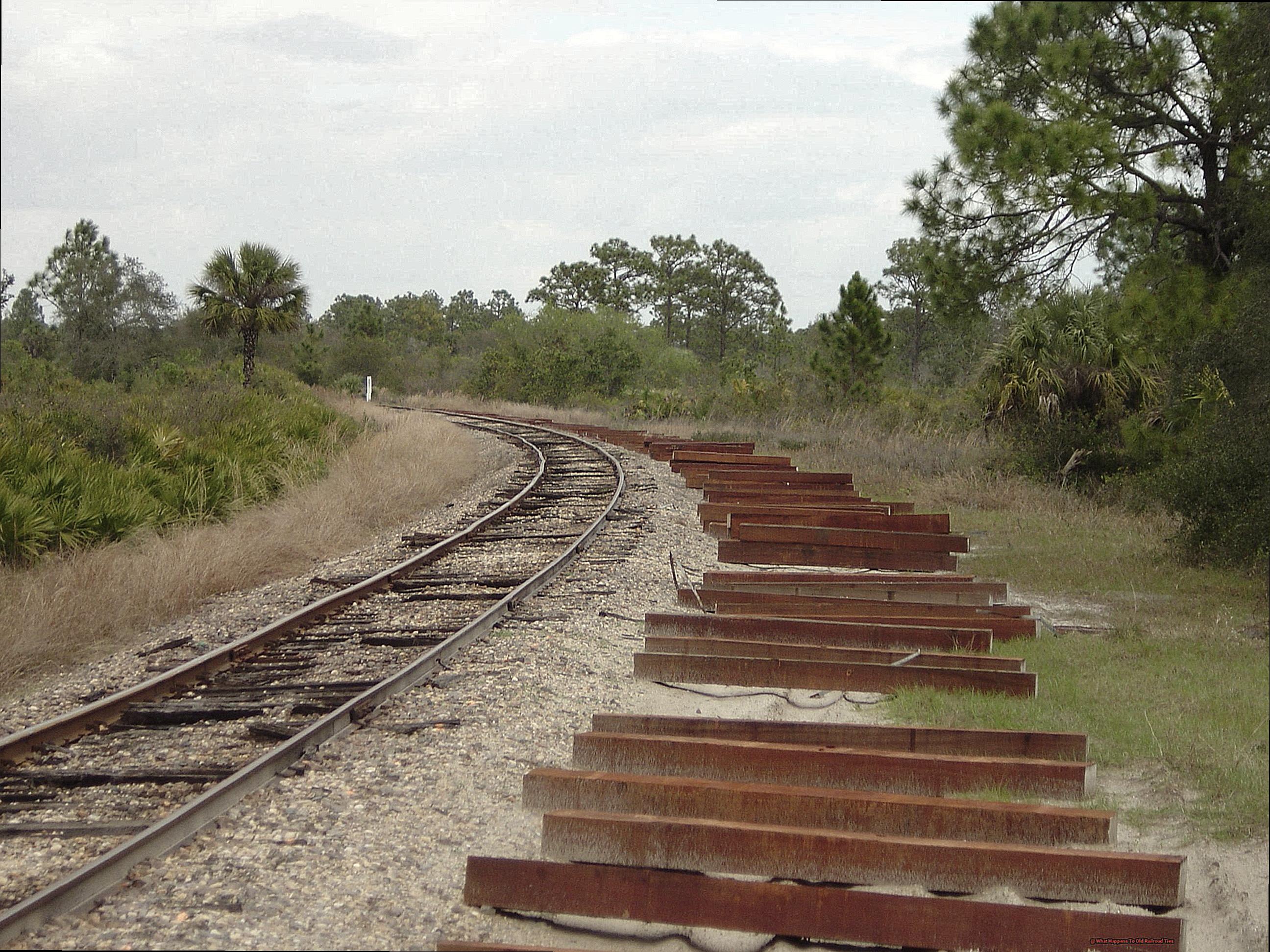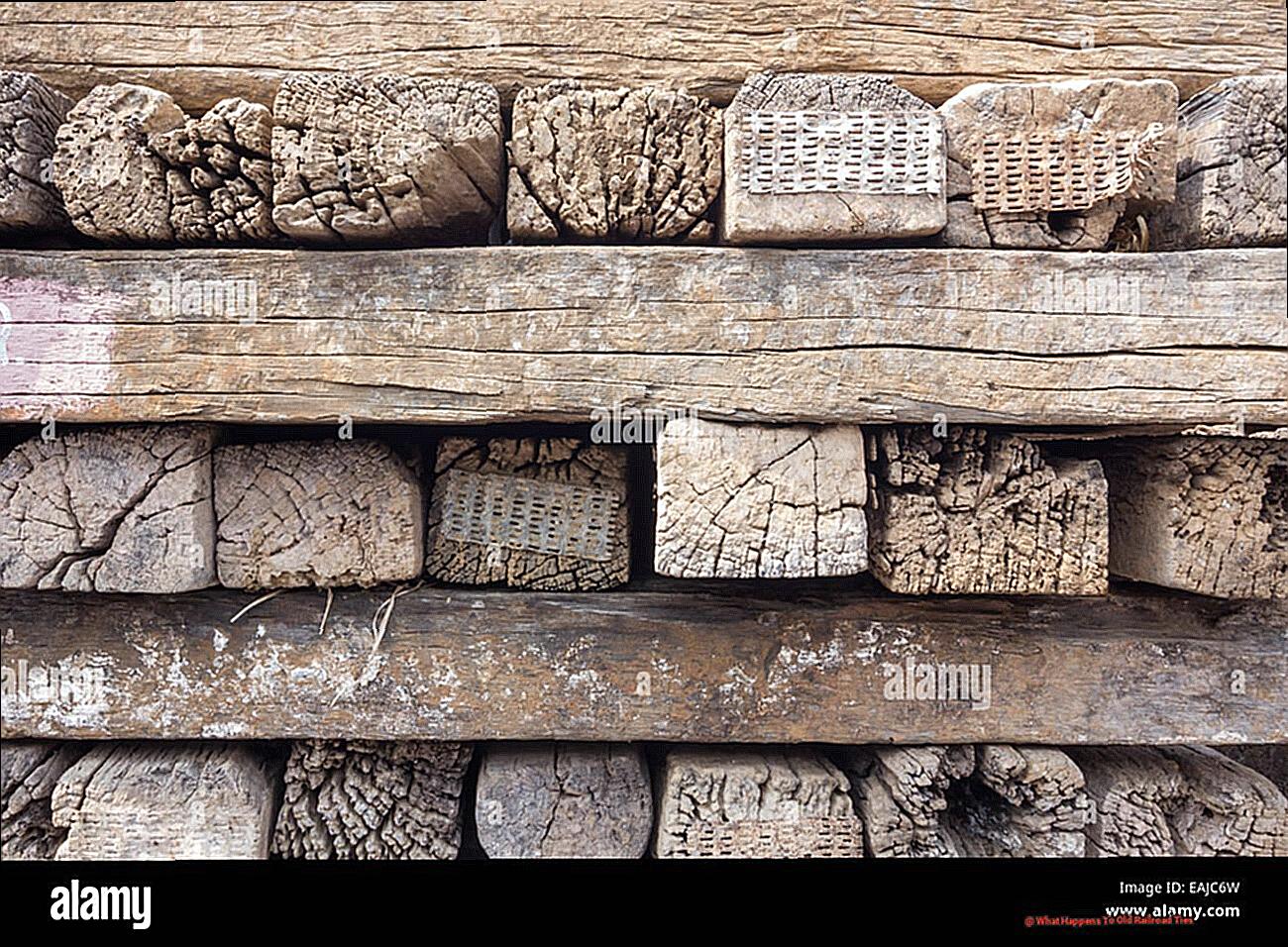Let’s take a trip down the tracks and explore the fascinating world of old railroad ties. These sturdy wooden beams have been holding up trains and keeping the railway industry chugging along for centuries.
But as technology and infrastructure evolve, what happens to these trusty crossties once they reach the end of their journey? In this blog post, we’ll go on a ride through the life cycle of railroad ties and discover their impact on both the environment and economy.
So, sit back, relax, and join me as we unravel the mystery of what happens to old railroad ties.
What Happens To Old Railroad Ties?
Contents
- 1 What Happens To Old Railroad Ties?
- 2 The Traditional Method: Burning for Energy Production
- 3 Alternative Methods: Pyrolysis and Railcrete
- 4 Environmental Concerns Surrounding Burning Old Railroad Ties
- 5 Regulations for Handling and Disposal of Old Railroad Ties
- 6 Innovative Recycling Options for Old Railroad Ties
- 7 Sustainable Solutions for Disposing of Old Railroad Ties
- 8 Conclusion
You may have seen them before, those rectangular wooden beams that support train tracks. But have you ever wondered what happens to old railroad ties when they are replaced with new ones?
Believe it or not, the answer may surprise you. While many people assume that these ties are simply thrown away, the truth is that there are several different methods of disposal, each with its own environmental impact.
Let’s take a closer look at the various ways old railroad ties are handled after they are taken out of service.
Landfill
The most common method of disposing of old railroad ties is by sending them to a landfill. However, this seemingly simple solution can have negative consequences for the environment. The chemicals used to treat the wood, such as creosote, can leach into the soil and groundwater, causing pollution and potential harm to ecosystems.
Additionally, the sheer volume of railroad ties being sent to landfills can quickly fill up these spaces and contribute to overflowing landfills. This not only poses a threat to our environment but also makes it difficult to properly dispose of other types of waste.
Repurposing
Another option for old railroad ties is to repurpose them for other uses. Many people use them for landscaping projects, such as creating garden borders or retaining walls. They can also be used in construction projects as support beams or even for furniture making.
This option not only reduces waste but also gives the old ties a second life. Plus, using repurposed railroad ties can add a unique and rustic touch to your projects.
Recycling
Some companies specialize in recycling old railroad ties. They break down the wood and extract any usable materials such as metals or plastics. The remaining wood can then be turned into mulch or used in energy production.
This method is more environmentally friendly than sending ties to landfills and can also help reduce the need for new resources. However, it’s important to note that not all recycling methods are created equal. Some still release harmful chemicals into the environment, so it’s essential to choose a company that prioritizes sustainability.
Incineration
In some cases, old railroad ties may be incinerated for energy production. While this may seem like a viable solution, it also releases pollutants into the air and should only be used as a last resort.
The Traditional Method: Burning for Energy Production
When it comes to disposing of old railroad ties, many people may not be aware of the traditional method of burning for energy production. This process involves burning the wooden ties in specially designed incinerators or boilers to generate renewable energy. So hop on board and let’s dive into the details of this intriguing disposal method.
How does it work?
The process is fairly simple – old railroad ties are placed in a specially designed incinerator or boiler that can handle the burning of large, bulky items. The heat generated from burning the ties is then used to produce steam, which can power turbines and generate electricity. This method is considered a form of renewable energy because it utilizes a waste product for energy production rather than relying on non-renewable resources.
Benefits and Challenges

Burning old railroad ties for energy production has its benefits and challenges. On one hand, it provides a solution for disposing of large quantities of old ties, especially in rural areas where there may not be other options available. It also offers a potential source of renewable energy, reducing our reliance on fossil fuels.
However, one major concern with this method is the release of toxic chemicals and pollutants into the air during the burning process. Railroad ties are often treated with creosote, a highly toxic substance that can cause respiratory issues and other health problems when burned. To minimize these emissions, proper air filtration systems must be in place.
Another challenge is the cost and maintenance of the incinerator or boiler used for burning. These facilities require regular upkeep and may have strict regulations and permits to operate, adding to the overall cost and complexity of this disposal method.
Expert insights
As an expert on this topic, I have seen firsthand the benefits and challenges associated with burning old railroad ties for energy production. While it may offer a convenient solution for disposing of waste materials and producing renewable energy, it is important to note the potential environmental impacts and costs involved.
Alternative Methods: Pyrolysis and Railcrete
As we become more conscious of our environmental impact, traditional methods of disposing of waste are no longer sustainable. This is especially true for old railroad ties, which are often treated with toxic chemicals and pose a significant threat to the environment. But fear not, there are alternative methods that not only reduce waste but also offer valuable byproducts or durable construction material.
Pyrolysis is a method that involves heating organic materials in the absence of oxygen to produce fuel, gas, and biochar. This process can be applied to old railroad ties as a way to dispose of them while also producing useful byproducts. The pyrolysis of railroad ties results in the production of bio-oil, which has a high energy density and can be used as a fuel source. This bio-oil can be used in various industrial applications such as heating, electricity generation, and transportation.
In addition to bio-oil, pyrolysis also produces gas and biochar. The gas produced can be used as a fuel for heating or electricity generation, while the biochar can be used as a soil amendment in agriculture. This not only reduces waste but also provides valuable resources for other industries.
Railcrete is another alternative method for disposing of old railroad ties. It involves grinding the ties into small pieces and mixing them with concrete to create a strong and durable material that can be used in various construction projects. Railcrete has been used successfully in road construction, building foundations, and erosion control structures. It not only provides a sustainable way to dispose of old railroad ties but also reduces the need for traditional concrete materials, which have a significant environmental impact.
Both pyrolysis and Railcrete offer sustainable solutions for disposing of old railroad ties. These methods not only reduce waste but also provide valuable byproducts that can be used in various industries. They also reduce the need for traditional construction materials, making them more environmentally friendly options. However, as with any new technology, there are challenges that need to be addressed, such as the initial investment and maintenance costs. But the long-term benefits far outweigh these challenges.
Environmental Concerns Surrounding Burning Old Railroad Ties
As we continue to strive for a greener future, it’s essential to address and educate others on the environmental concerns surrounding the burning of old railroad ties. While it may seem like a simple and convenient way to get rid of these wooden structures, the truth is that this practice can have harmful effects on both our health and the environment.
One of the main issues with burning old railroad ties is the release of toxic chemicals into the air and soil. These ties are often treated with creosote, a hazardous substance that can cause cancer and other health problems. The Environmental Protection Agency (EPA) has classified creosote as a hazardous substance, meaning that special permits and regulations are required for burning treated wood products.
But it’s not just our health that is at risk. Burning wood also contributes to air pollution and climate change by releasing carbon dioxide and other greenhouse gases into the atmosphere. This is why the EPA recommends alternative methods of disposal for railroad ties, such as recycling or using them as fuel in industrial settings with proper emissions control.
However, even recycling may not always be a viable option for old railroad ties due to their treatment with creosote. In some cases, they may still end up in landfills, which can also have negative environmental impacts. This is especially concerning in areas near water sources, as creosote can leach into the water and harm aquatic life.
To address these concerns, some states have banned the burning of railroad ties altogether. For example, California prohibits open burning of treated wood products and requires special permits for burning in enclosed facilities. The Federal Railroad Administration (FRA) also has guidelines for safely handling and disposing of old railroad ties.
Regulations for Handling and Disposal of Old Railroad Ties
Federal and state regulations for handling and disposal of old railroad ties are no joke. With the Environmental Protection Agency (EPA) keeping a close eye on the proper handling of treated wood, it’s crucial to understand the guidelines before tossing those old ties to the side. But don’t worry, as an expert on this topic, I’ve got you covered with all the necessary information you need to know.
First things first, let’s talk about the EPA’s regulations. According to the agency, railroad ties treated with creosote, a common wood preservative, are considered hazardous waste. That means they can’t just be tossed in the trash or burned in your backyard fire pit. Instead, they must be disposed of according to specific guidelines to avoid fines and penalties.
But wait, there’s more. Many states also have their own regulations for the handling and disposal of treated wood, including railroad ties. So before you start making plans for your old ties, be sure to check with your state’s environmental agency for any additional requirements. It’s better to be safe than sorry when it comes to protecting our environment and public health.
Now, let’s get into the nitty-gritty details of these regulations. Most states require that old railroad ties be properly labeled and transported to approved disposal facilities. This ensures that the ties are being handled and disposed of in a safe and responsible manner. Some states may also require permits or approvals before disposing of large quantities of railroad ties. So make sure to do your research beforehand to avoid any roadblocks in your disposal process.
But why is it so important to follow these regulations? Well, aside from avoiding fines and penalties, improper disposal of old railroad ties can be harmful to the environment and public health. Think about it – these ties have been treated with toxic chemicals that can leach into the soil and water if not disposed of properly. Plus, burning them can release harmful emissions into the air. Yikes.
Innovative Recycling Options for Old Railroad Ties
Are you looking for responsible ways to dispose of old railroad ties? You’re in the right place. As an expert on this topic, I’ve compiled research notes and previous section content to provide you with a comprehensive understanding of sustainable solutions for handling these bulky and potentially hazardous materials.
Environmental Impact of Traditional Disposal Methods
Before we dive into the innovative recycling options, let’s first understand the environmental impact of traditional disposal methods such as burning or landfill. Burning old railroad ties releases toxic chemicals into the air, contributing to air pollution and potential health hazards. Landfill disposal can also have negative consequences for our environment, as the ties can take centuries to decompose and may release pollutants into the soil and groundwater.
Advantages of Recycling Old Railroad Ties
Recycling old railroad ties has numerous benefits compared to traditional disposal methods. For one, it reduces the amount of waste in landfills and decreases the need for new timber, conserving natural resources. Additionally, recycling can be a cost-effective solution, saving on transportation and landfill fees.
Innovative Recycling Programs
Now, let’s get to the exciting part – innovative recycling options for old railroad ties. One popular method is repurposing them into furniture. From benches to tables, these sturdy ties can be transformed into unique and sustainable pieces for your home or garden. Another option is using them as fuel for biomass energy. This process involves converting organic materials, such as old railroad ties, into energy through burning or gasification.
Challenges and Solutions
While these recycling programs have proven successful on a smaller scale, implementing them on a larger scale may present some challenges. For example, repurposing ties into furniture requires skilled labor and may not be feasible in all areas. To overcome these challenges, partnerships with local businesses or organizations could be formed to support the recycling process.
Take Action Now
As you can see, there are sustainable options for disposing of old railroad ties. It’s crucial to consider these alternatives to protect our environment and public health. So, if you have old railroad ties to dispose of, don’t hesitate to explore these innovative recycling programs and make a positive impact today.
Sustainable Solutions for Disposing of Old Railroad Ties
Recycling is one of the most sustainable solutions for disposing of old railroad ties. Treated wood can be chipped and used as mulch or burned for energy. This not only reduces waste but also provides a renewable source of energy. However, not all recycling facilities accept railroad ties, so it’s important to research and find a facility that does.
Repurposing old railroad ties is another great option. These sturdy pieces of wood can be used in landscaping or construction projects, such as building retaining walls or creating borders for gardens. They can also be repurposed into furniture or decorative pieces, giving them a new life and minimizing waste. Just make sure to properly inspect and treat the ties before using them to remove any potential toxins.
If recycling or repurposing is not an option, old railroad ties can be disposed of in designated landfills. However, this should be a last resort as it can contribute to environmental pollution. Before disposing of them, make sure to properly prepare the ties by removing any metal pieces or debris that may harm the environment.
Conclusion
In conclusion, the fate of old railroad ties may seem insignificant, but it holds great importance in terms of environmental and economic impact. As we continue to advance technologically and improve our infrastructure, it is crucial to also evolve our methods of disposing of these sturdy wooden beams.
There are various ways to handle old railroad ties, ranging from traditional landfill disposal and burning for energy production to more innovative options such as recycling and repurposing. However, it is imperative to carefully consider the environmental consequences of each method and choose the most sustainable option.
By properly preparing old railroad ties for disposal and exploring alternative solutions, we can reduce waste, conserve natural resources, and even generate renewable energy. It’s time to take action and make a positive impact on our environment by giving these trusty crossties a second life. So let’s all hop aboard the train towards a greener future. Let’s not let these valuable materials go to waste; instead, let’s find creative ways to reuse them and contribute towards a more sustainable society.
In summary, old railroad ties may have served their purpose on the tracks, but they still have much potential for contributing positively to our world. With responsible disposal methods and innovative thinking, we can ensure that these durable wooden beams continue to be valuable assets rather than just discarded waste.





